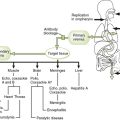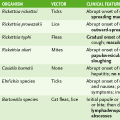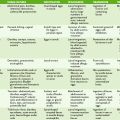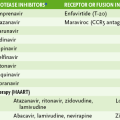Nonenveloped (Naked) DNA Viruses
• Midsized viruses with a linear double-stranded DNA genome and naked, icosadeltahedral capsid that has fibers extending from the vertices.
1. Fibers extending from viral capsid bind to specific receptors on epithelial and other cells.
2. Primary lytic infection with accompanying inflammation occurs in mucous membranes of the respiratory tract, gastrointestinal tract, conjunctiva, and cornea.
3. Persistent, latent infection in lymphoid tissues (e.g., tonsils, adenoids, and Peyer patches) is common.
B Adenoviral illnesses (Table 21-1)
TABLE 21-1
Common Illnesses Associated with Adenoviruses
| Type of illness | Clinical features |
| Acute febrile pharyngitis | Fever, sore throat, cough, coryza, and other symptoms that may mimic streptococcal infection |
| Most common in young children (<3 yr) | |
| Acute respiratory disease | Rapid onset of fever, cough, sore throat, rhinorrhea, and cervical adenitis |
| Occurs mostly in military recruits | |
| Pharyngoconjunctival fever | Similar to acute pharyngitis but accompanied by conjunctivitis (“pink eye”) |
| Occurs in older children, often in outbreaks associated with use of poorly chlorinated swimming pools | |
| Preauricular lymphadenopathy important diagnostic finding | |
| Atypical pneumonia | Nonproductive cough with pulmonary infiltrates and effusions |
| Seen in children and adults | |
| Epidemic keratoconjunctivitis | Inflamed pebbled conjunctiva (pink eye) in adults similar to conjunctivitis in children but of longer duration and followed by keratitis |
| Usually associated with irritation to eye by dust or other debris | |
| Gastroenteritis | Diarrhea with possible vomiting primarily in infants and young children due to serotypes 40-42 |
| Other serotypes (e.g., 25-28) cause diarrhea in hospitalized patients. | |
| Acute appendicitis | Lymphoid hyperplasia in appendix compromises blood supply leading to acute inflammation. |
1. Incubation period for acute adenoviral illness is 4 to 9 days, but virions may be released for long periods, even after resolution of symptoms.
2. Acute, self-limited illness is the most common manifestation of adenoviral infection.
3. Infections occur primarily in children, military recruits, and immunocompromised individuals.
1. Dense, basophilic intranuclear inclusion body within infected cells is diagnostic of adenoviruses.
2. Adenovirus serotypes can be distinguished by immunoassay, DNA probe, or polymerase chain reaction (PCR) analysis of cultured specimens.
1. As naked capsid viruses, adenoviruses are resistant to drying and detergents and are very contagious.
2. Virions are spread via aerosols, fecal-oral route, fomites, and close contact and in inadequately chlorinated swimming pools.
F Adenovirus is used for gene replacement therapy and as a hybrid vaccine.
II Papilloma and Polyomaviridae (Papova)
1. The papillomaviruses and polyomaviruses are small, naked, icosahedral capsid viruses with double-stranded DNA genomes. They used to be grouped together as the Papovaviridae.
2. Lytic, chronic, latent, or transforming infections may be established depending on the host cell.
B Human papillomaviruses (HPVs)
• HPVs infect and replicate in cutaneous and mucosal epithelial tissue.
• Early viral proteins E6 and E7, which inactivate cellular tumor suppressor proteins (RB and p53 [TP53]), promote hyperplasia of host cells in the basal layer of infected epithelium.
2. Diseases associated with HPVs (Table 21-2)
TABLE 21-2
Diseases Caused by Human Papillomaviruses
| Condition | Serotypes* | Clinical and histologic features |
| Skin warts | 1-4 | Benign lesions on keratinized surfaces usually of hands and feet (not mucous membranes) |
| Most common in children and young adults | ||
| Hyperplasia of prickle cells and hyperkeratosis seen microscopically | ||
| Anogenital wart (condyloma acuminata) | 6, 11 | Benign growths on squamous epithelium of external genitalia and perianal regions |
| Thickened epithelium with fibrous overgrowths | ||
| Laryngeal papillomas | 6, 11 | Benign tumors, can be life threatening in children owing to airway obstruction |
| Most common in children and middle-aged adults | ||
| Cervical intraepithelial neoplasia | 16, 18 | Progressive changes in cervical mucosa leading to dysplasia and possible carcinoma in situ |
| Koilocytotic cells (pyknotic nuclei and cytoplasmic vacuoles) seen on Papanicolaou test |
*Most common serotypes associated with particular condition; others may also cause similar manifestations.
• More than 40 HPV serotypes are associated with epithelial lesions in different sites.
• Clinical features, histology of lesions, and PCR are the usual basis for diagnosis of HPV infection because viruses cannot be isolated in tissue culture.
3. Association with cervical carcinoma: HPV 16, 18, 31, 33
• HPV is spread by direct contact with skin warts, through sexual contact with anogenital lesions, and from infected mother to infant during birth.
• BK virus and JC virus, the only human pathogens in this group, are ubiquitous but rarely cause disease in healthy individuals.
• Polyomavirus genome is circular double-stranded DNA.
• Primary infection of the kidney by BK or JC virus is generally asymptomatic and becomes latent.
• Reactivation of latent infection may occur in immunocompromised individuals and pregnant women.
2. Reactivation diseases (in immunocompromised individuals)
• Progressive multifocal leukoencephalopathy (PML) results from reactivation of JC virus, followed by viremia and spread to the central nervous system.
a. Patients undergo slow accumulation (progressive) of multiple (multifocal) neurologic symptoms, including impairment of speech, sight, coordination, and mental abilities leading to paralysis and death.
b. Brain tissue histology shows abnormal oligodendrocytes near areas of demyelination.
• Urinary tract infection, which may be severe, and viruria (viral shedding in the urine) result from reactivation of BK virus.
• BK virus reactivation is prevalent in kidney transplant recipients.
• This family of very small viruses with a naked, icosahedral capsid and linear single-stranded DNA genome includes only one human pathogen, parvovirus B19.
1. Initial infection with B19 at the site of entry (usually upper respiratory tract) is followed by viremic spread to rapidly dividing erythroid precursor cells in bone marrow.
2. Cytolytic replication in erythroid precursor cells and subsequent immune response cause manifestations of B19 infection.
B Diseases caused by parvovirus B19
1. Erythema infectiosum (fifth disease) is a biphasic disease that occurs mainly in children aged 4 to 15 years.
• Initial phase, reflecting lytic infection, is marked by nonspecific flu-like symptoms and decreased hemoglobin levels.
• Immune-mediated phase, beginning 2 to 3 weeks later, is characterized by rash and arthralgia.
2. Polyarthritis in adults may not be preceded by rash.
3. Aplastic crisis may result from B19 infection in those with sickle cell disease or other chronic hemolytic anemia.
• Transient reticulocytopenia (7 to 10 days) leads to decreased hemoglobin levels.
• Symptoms include fever, malaise, itching, chills, possibly arthralgia, maculopapular rash, and joint swelling.
4. Fetal infection results in stillbirth (hydrops fetalis) but not in congenital abnormalities.







